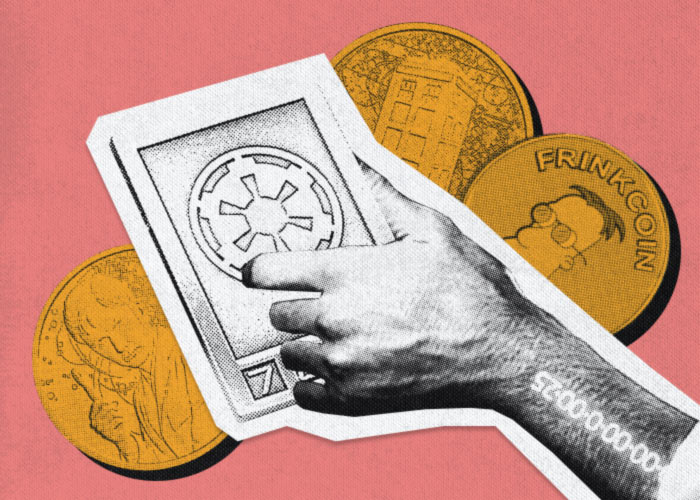Screenwriters, especially those responsible for creating fantasy worlds and movie universes, often introduce fictional virtual assets into the setting, eventually becoming an integral part of the plots and the overall context of the events. They represent innovative visions of the future of financial systems and open up additional possibilities for artistic expression for authors.
Let’s dive into the cinematic world and trace when, how, and why screenwriters and filmmakers introduced virtual assets into their works.
Galactic Epics

Movies created and released before 2000 often used various virtual assets to build future financial systems. This technique is mainly found in various galactic epics and space operas, emphasizing the possibility of global standardization of money. Every famous movie about intergalactic travel uses digital currencies as the main means of payment.
Here’s the clearest evidence of that:
- Doctor Who, the original series that ran from 1963 to 1989. The show’s universe uses a special kind of currency, a Time Lord currency. This virtual currency helps the authors to create a sense of unified economic space. There’s another digital currency in the series called galactic credits. These are used by various societies as a means of exchange and payment for interplanetary trade and commerce. For example, the characters in the series paid for transport rent, technology purchases, or services provided by various civilizations all with galactic credits.
- The Star Trek media franchise, consisting of a television series that has aired from 1966 to the present day, ten feature films, comic books, and a host of other products. The Star Trek universe uses a virtual currency called federation credit as its unit of payment. It’s the accepted currency of the United Federation of Planets and other intergalactic organizations. It’s used to purchase goods and services, pay for transportation, rent spaceships, and other transactions. Although cash is less important than progress, research, and personal development in the Star Trek universe, it’s still the primary means of payment in this fictional space with which the writers simplify economic transactions in the film.
- The Star Wars media franchise, including numerous works (12 feature films and TV series that have been released since 1977 to the present day). The main currency used in the Galactic Republic, the Galactic Empire, and other factions and systems in the Star Wars universe is the Galactic Credit Standard. This virtual currency is accepted in all planetary systems and space stations.
- The anime series Cowboy Bebop (1998). The economic system in the series is built around the cryptocurrency Woolong, which serves as a unit of exchange in the solar system where the events of the series take place. The digital currency is mentioned as a way to pay for services, goods, and information.
After 2000, filmmakers and screenwriters continued to use virtual assets as the primary means of payment in galactic epics. For example, in The Hitchhiker’s Guide to the Galaxy, the main characters use the Altarian Dollar to interact with space civilizations. It’s the global unit of value exchange in the film’s universe.
The digital currency isn’t mentioned in the original 1984 Dune media franchise film, nor is it in the books. However, the 2021 film adaptation features the cryptocurrency Solari, which serves as the main unit of currency in the universe.
The Marvel Cinematic Universe also features virtual currencies. The Guardians of the Galaxy movie series mentions Units, the universal currency in the galaxy. Other films in the MCU don’t mention them.
Fantasy Films

Besides space epics, fictional virtual assets are often found in fantasy movies with less extensive plots. Here are some of them:
- The 1990 sci-fi action film Total Recall, starring Arnold Schwarzenegger. In the context of a future society where the world is divided into two factions, Earth and Mars, and the main conflict is about access to resources, a unit of virtual currency, Energy Credits, appears. It serves as a means of exchange and payment for energy use and is the same currency for both factions. Interestingly, it no longer appears in the 2012 remake.
- The 1987 RoboCop movie mentions the virtual currency ED-209 Credits. Unlike the galactic universes, this asset isn’t a global monetary unit in the film. Instead, it’s used as the internal currency of Omni Consumer Products.
After 2010, the topic of virtual worlds became especially relevant for screenwriters. This is primarily due to the trend for Metaverses, which originated in fiction and caused quite a response from readers. And what can be more successful at the box office than a bestseller adaptation?
Here are some of the brightest cyberpunk movies and their fictional virtual assets:
- Tron: Legacy, or TR2N (2010). The main character ends up inside a computer program where Units are used as a means to make purchases and gain access to various resources. The filmmakers emphasize the importance of the economic system in virtual reality, and the use of digital currency in the movie creates a futuristic atmosphere.
- Jumanji: Welcome to the Jungle (2017). The film mentions the virtual currency Cyberbucks that can be earned and used within the game world. With Cyberbucks, the filmmakers showed the mechanisms of the virtual economy, where players can use the currency to advance through the story.
- Ralph Breaks the Internet (2018). The animated film tells the story of the characters who travel to different online worlds and play virtual games. In one such world (Slaughter Race), there’s a reference to the virtual currency Bally Bucks. The characters can earn and spend it to buy items, upgrades, and other things.
- Ready Player One (2018). It mentions two types of virtual currency: Reality Coin and OASIS Coin. Both assets can be earned and used in virtual reality, but the Reality Coin has value outside of the OASIS Metaverse. Such a plot move underscores the impact of the virtual economy on real life, which is the main theme of the film. By the way, the movie is often cited as a prime example of a critique of the Metaverse concept.
Comedy Films

The hype around cryptocurrencies prompted screenwriters to use virtual assets as a kind of satirical counterpart to money. Fictional cryptocurrencies in some popular TV series and shows began to appear for the sole purpose of mocking the community’s uneducated attitude towards crypto.
The most obvious example of this trend can be seen in the animated series The Simpsons. In Episode 13 of Season 31, Professor Frink creates his own cryptocurrency named Frinkcoin. This cryptocurrency becomes popular and causes financial chaos. People start investing in it, hoping for quick profits, which leads to problems and ups and downs in the price of the cryptocurrency. This episode is a humorous comment on today’s financial trends.
Jokes and parodies about virtual currencies were also often found in the popular animated series Futurama. There were references to the fictional virtual coins Bitcoinium (not hard to guess which real currency it’s equivalent to), Robo-Dollars, and Fleck. All references have a comedic nature and emphasize the futuristic nature of technological progress, and they also highlight global trends of accepting cryptocurrencies as units of exchange. By the way, the comedic remarks about cryptocurrencies may be the reason why the series can successfully return to action after a ten-year hiatus — Season 8 is scheduled to premiere at the end of July 2023.
Crime Dramas

Beyond sci-fi and humorous contexts, virtual assets are most often mentioned in terms of criminal activity. They have begun to be woven into plots, helping to create an atmosphere of technological crime by highlighting changes in the quality and nature of offenses.
For example, in the 2015 film Zero Effect, virtual currencies are mentioned in the context of the criminal world and the trafficking of illicit goods and services. And in the 2019 film Crypto, fictional cryptocurrencies are used to conduct illegal transactions, serving as a tool for money laundering and financial manipulation.
In the 1996 film Trainspotting, the characters use C-Bits to buy drugs. The use of digital currency in the film is intended to emphasize the scale of the underground economy associated with drug trafficking and how advanced dealers are with the new technology. It’s worth noting that at the time, the world didn’t yet know about Bitcoin and cryptocurrencies, so the appearance of their prototypes in the film was perceived as something super-technological and incomprehensible.
Original Variants of Virtual Currencies in Movies

Filmmakers also started using virtual assets as a kind of allegorical interpretation of money, thus redefining the value of financial ecosystems. For example:
- Downsizing (2017). The film is an adaptation of Cory Doctorow’s Down And Out In the Magic Kingdom, published in 2003. Both the book and the film feature the virtual currency Whuffie, which is a measure of social prestige and a person’s reputation in society. Whuffie is measured and accumulated on social networks and in public events and gives access to various privileges.
- In Time (2011). In the context of the film, time is literally the currency. The main characters, living in a future where everyone’s time is predetermined, use it as a means of exchange and payment for goods and services. The use of time as a virtual currency helps the filmmakers emphasize the social and economic inequalities in society.
To sum up, virtual currencies are very popular among filmmakers and screenwriters, who use them to shape the setting, create the necessary atmosphere, and add some artistic expression, showing their attitude to certain phenomena or stressing social trends that exist here and now. So, as the popularity of digital assets grows and the excitement around them increases, real cryptocurrencies and their fictional counterparts will appear more often in various series and films, turning from a gimmick into reality. This is already happening with Bitcoin and some altcoins.




